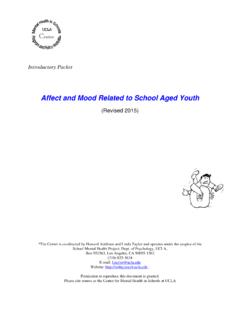Transcription of Cyberbullying: Resources for Intervention and Prevention
1 Universal Journal of Educational Research 1(3): 133-145, 2013 DOI: Cyberbullying: Resources for Intervention and Prevention Charles E. Notar*, Sharon Padgett , Jessica Roden Secondary Education Department, Jacksonville State University, 700 Pelham Road N Ramona Wood Building A-3 , Jacksonville, AL 36265-1923, United States of America *Corresponding Author: Copyright 2013 Horizon Research Publishing All rights reserved. Abstract Cyberbullying is of major concern in the educational field. Unlike normal bullying cyberbullying is anonymous and can take place anywhere which is a major problems for schools. Topics covered in the article are types of cyberbullying and can happen anywhere.
2 What Resources are available today to combat cybullying. The article reviewed all article from 2005-2013 that related to cyberbullying Resources . Roles in cyberbullying, school climate, Prevention and Intervention programs, law and Resources available are topics covered in the article. There is a myriad Prevention and Intervention program. More research is needed due to the various school systems approach to cyberbullying Prevention and Intervention . Keywords Cyberbullying, Prevention And Intervention Programs, Cyber Aggression, School Climate 1. Negative Aspects of cyberbullying Relationship problems, victims experience powerfully negative effects (especially on their social well-being); and the reactive behavior, both from schools and from students, was generally inappropriate and ineffective [1].
3 A Patchin and Hinduja [2] study found students who experienced cyberbullying, both as a victim and an offender, had significantly lower self - esteem than those who had little or no experience with cyberbullying. Cyberbullying impacts students wellbeing, schooling, and and peer relationships of many young people [3]. The negative impacts of bullying on schooling, relationships and the emotional and psycho- logical health of young people who are its victims can be long term; in some cases, the impacts continue into early adulthood [4]. There are also long-term implications for bullies; for example, they have been found to typically exhibit higher levels of antisocial, violent and/or criminal behavior in adulthood [4, 5].
4 These impacts, both for the bully victim and the bully, create ongoing social and economic costs for the community. As the penetration and use of communication technologies grows, especially among young people, it is necessary to consider the potential for cyberbullying to increase the frequency and severity of victimisation [3]. By all accounts, cyberbullying is an increasingly serious public mental health problem with sometime devastating consequences [6, 7]. Cyberbullying has an effect on both teachers and those being cyberbullied. Qualitative evidence gathered through a survey of teachers has demonstrated that cyberbullying affects the working lives of staff and impacts severely on staff motivation, job satisfaction and teaching practice.
5 Cyberbullying victims face various academic and social problems. They range from withdrawal from school activities, school absence, and school failure, to eating disorders, substance abuse, depression, and even suicide [ , 8, 9] At the very least, cyberbullying undermines the freedom of youth to use and explore online Resources [10]. National Crime Prevention Council s [11] website identified four important themes that can help schools better understand the nature of the cyberbullying phenomenon and what they might do to support students has been identified by various studies. First, the high percentage of students being affected by cyberbullying and the content of the messages suggest cyberspace can be a graphic, scary, threatening, and generally pretty unsettling virtual world with few laws or norms for socially acceptable behavior.
6 Typical teen tensions around relationship issues, including break-ups' envy, intolerance, and ganging up, are playing out in a far more dangerous environment. Students, who often lack the moral compass or leadership skills to govern themselves, are increasingly interacting with peers in this unsupervised setting. Adults, who normally would be supervising the lives of teens, are left on the outside - without the technological expertise or understanding of the environment to be of much help. The study suggests that cyberspace operates like the Wild West once did where anything goes. People take the law into their own hands and retaliate because there is no governance structure to protect them from further victimization.
7 Until schools, courts, parents, and internet/technology providers join forces to establish and enforce behavioral standards in cyber-space, students' lives are being negatively affected by a very uncivilized virtual world that is spilling over into their real lives. Second, cyberbullying is causing students to experience feelings of anger, powerlessness, fear, and sadness. In other words, cyberbullying has some of the same negative 134 Cyberbullying: Resources for Intervention and Prevention outcomes for targets as face-to-face bullying, which studies have shown leads to (among other things) sadness and depression, powerlessness, fear, and delinquency [12], or more aggressive/retaliatory behavior/ The added dilemma is that cyberbullying is easier because of the anonymity of the attack.
8 It is more pervasive with high numbers of students participating, by-standing, and/or being targeted. Cyber targets can feel helpless because they do not know what to do to make it stop [1]. Third, it is clear that students are not equipped to handle generally do not seek help because of fear of reprisal, embarrassment, or because they assume adults will not act. Some try to avoid the situation which may stop a particular incident but does little to protect them long-term or discourage the cyberbully. Some become very withdrawn which can affect their school work, their friendships, and ultimately lead them to dangerous, self -destructive behavior.
9 For those students who do take action, they often wait until the bullying reaches intolerable levels and then retaliate, which is inappropriate and potentially very dangerous. Indeed, the data show a pattern that bullying begets bullying, reflecting the kind of cycles we see in other social systems, which are insidious in their reinforcement of the problem and extremely difficult to interrupt[1]. Adolescence is a particularly important time for identity development. During this period, a youth s social environment and social interactions with peers largely influence the identity formation process.
10 Thus, adolescents seek behaviors, situations, and social environments that help value themselves positively and avoid those that affect them negatively. Overall, this affects a child s perceptions and acceptance of his or her changing self , and it plays a critical role in directing his or her personal and even professional growth trajectory. The Journal of Adolescent Health recently released a study that examined the association between depression and frequency of involvement in cyberbullying. It concluded that experience with cyberbullying has a more negative effect on adolescent development than traditional bullying, and victims may suffer long term sociological and psychological consequences.













